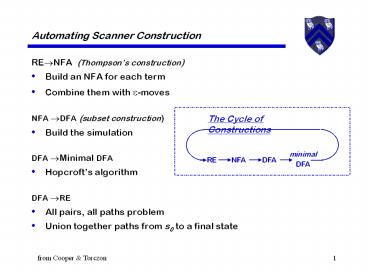Automating Scanner Construction PowerPoint PPT Presentation
Title: Automating Scanner Construction
1
Automating Scanner Construction
- RE?NFA (Thompsons construction)
- Build an NFA for each term
- Combine them with ?-moves
- NFA ?DFA (subset construction)
- Build the simulation
- DFA ?Minimal DFA
- Hopcrofts algorithm
- DFA ?RE
- All pairs, all paths problem
- Union together paths from s0 to a final state
2
RE ?NFA using Thompsons Construction
- Key idea
- NFA pattern for each symbol each operator
- Join them with ? moves in precedence order
Ken Thompson, CACM, 1968
3
Example of Thompsons Construction
- Lets try a ( b c )
- 1. a, b, c
- 2. b c
- 3. ( b c )
4
Example of Thompsons Construction
(continued)
- 4. a ( b c )
- Of course, a human would design something simpler
...
But, we can automate production of the more
complex one ...
5
NFA ?DFA with Subset Construction
- Need to build a simulation of the NFA
- Two key functions
- Move(si,a) is set of states reachable by a from
si - ?-closure(si) is set of states reachable by ?
from si - The algorithm
- Start state derived from s0 of the NFA
- Take its ?-closure
- Work outward, trying each ? ? ? and taking its
?-closure - Iterative algorithm that halts when the states
wrap back on themselves - Sounds more complex than it is
6
NFA ?DFA with Subset Construction
The algorithm s0 ???-closure(q0n ) while ( S is
still changing ) for each si ? S for each ?
? ? s?? ?-closure(move(si,?)) if (
s? ? S ) then add s? to S as sj
Tsi,? ? sj Lets think about why this works
The algorithm halts 1. S contains no
duplicates (test before adding) 2. 2Qn is
finite 3. while loop adds to S, but does
not remove from S (monotone) ? the loop halts S
contains all the reachable NFA states It tries
each character in each si. It builds every
possible NFA configuration. ? S and T form
the DFA
7
NFA ?DFA with Subset Construction
- Example of a fixed-point computation
- Monotone construction of some finite set
- Halts when it stops adding to the set
- Proofs of halting correctness are similar
- These computations arise in many contexts
- Other fixed-point computations
- Canonical construction of sets of LR(1) items
- Quite similar to the subset construction
- Classic data-flow analysis ( Gaussian
Elimination) - Solving sets of simultaneous set equations
- We will see many more fixed-point computations
8
NFA ?DFA with Subset Construction
- Remember ( a b ) abb ?
- Applying the subset construction
- Iteration 3 adds nothing to S, so the algorithm
halts
contains q4 (final state)
9
NFA ?DFA with Subset Construction
- The DFA for ( a b ) abb
- Not much bigger than the original
- All transitions are deterministic
- Use same code skeleton as before
10
Where are we? Why are we doing this?
- RE?NFA (Thompsons construction) ?
- Build an NFA for each term
- Combine them with ?-moves
- NFA ?DFA (subset construction) ?
- Build the simulation
- DFA ?Minimal DFA
- Hopcrofts algorithm
- DFA ?RE
- All pairs, all paths problem
- Union together paths from s0 to a final state
- Enough theory for today
11
Building Faster Scanners from the DFA
- Table-driven recognizers waste a lot of effort
- Read ( classify) the next character
- Find the next state
- Assign to the state variable
- Trip through case logic in action()
- Branch back to the top
- We can do better
- Encode state actions in the code
- Do transition tests locally
- Generate ugly, spaghetti-like code
- Takes (many) fewer operations per input character
char ? next character state ? s0 call
action(state,char) while (char ? eof) state ?
?(state,char) call action(state,char)
char ? next character if ?(state) final then
report acceptance else report failure
12
Building Faster Scanners from the DFA
- A direct-coded recognizer for r Digit Digit
- Many fewer operations per character
- Almost no memory operations
- Even faster with careful use of fall-through
cases
13
Building Faster Scanners
- Hashing keywords versus encoding them directly
- Some compilers recognize keywords as identifiers
and check them in a hash table
(some well-known compilers do this!) - Encoding it in the DFA is a better idea
- O(1) cost per transition
- Avoids hash lookup on each identifier
- It is hard to beat a well-implemented DFA scanner

